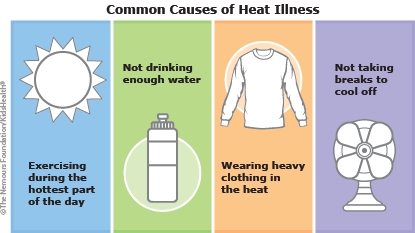Heat illness happens when problems develop because the body can't cool itself down. The three main types of heat illness are heat cramps, heat exhaustion, and heatstroke. Heatstroke is a medical emergency. Without treatment, it can lead to death. Here are some ways to help protect your kids from heat illness.

To prevent heat illness, kids should:
- Drink plenty of liquids. Health care providers might recommend that kids who do endurance sports (such as football, running, tennis, or soccer) or exercise in hot weather drink liquids with salt in them (such as oral electrolyte solutions or sports drinks) or add salt to their food. Ask your health care provider about the right amount of salt for your child.
- Start slowly when exercising in hot weather. They should increase how long and hard they exercise gradually (over at least a week) so their body can adjust.
- Avoid exercising outside between noon and 6 p.m., the hottest part of the day.
- Take frequent breaks when exercising in the heat.
- Wear sunscreen. Sunburned skin can worsen heat illness.
- Dress in light clothing and only wear the minimum gear needed to stay safe when exercising in hot weather. For example, at football practice when working on endurance through running, they can take off their helmet and padding.
- Avoid exercising in the heat when sick or taking any new medicines, especially if they have a fever.
- Avoid caffeine, which draws water out of the body through pee.
- Take any supplements or vitamins as recommended by your health care provider.
Other safety tips:
- Don't ever leave kids alone in a parked car. Even on a mild, sunny day, temperatures inside a car can reach dangerous levels.
- Talk to your health care provider and coaches before your child starts any exercise plan if they are overweight, have been diagnosed with sickle cell trait or another medical condition, or take any medicines.
- Talk to kids about the dangers of heat illness. Teach them that they should stop exercising and cool off right away if they feel extremely hot or thirsty, weak or tired, or have cramps or other symptoms.
- Be sure all your child's coaches and athletic trainers understand the dangers of heat illness and that they take safety precautions when the weather is very hot or humid (such as shortening or canceling practice or moving practice indoors).

You have other questions about preventing heat illness.

What are the kinds of heat illnesses? The main types of heat illness are heat cramps, heat exhaustion, and heatstroke:
- Heat cramps: These muscle cramps happen when it's very hot outside, usually while someone is doing intense exercise. They usually go away with rest and drinking liquids.
- Heat exhaustion: Someone with heat exhaustion has an increased body temperature and is dehydrated. Symptoms can include weakness, lightheadedness, pale and very sweaty skin, a headache, and cramps. The person may feel nauseated and vomit or have diarrhea. They need to cool down and drink liquids right away, so the illness doesn't get worse.
- Heatstroke: If the body temperature of someone with heat exhaustion continues to rise, they may get heatstroke, which is a life-threatening emergency. They may be confused, pass out, or have seizures. They need medical care right away to bring their body temperature down as fast as possible.
How is heat illness treated? The most important thing to do for any kind of heat illness is to cool the person down and give liquids as soon as possible:
- Take them to a cool place, with air conditioning if possible.
- Put ice packs or wet, cool cloths on their skin, especially on the neck, groin, and armpits. You can also pour cool water onto their head and skin.
- Remove any extra clothing as they start to cool down.
- Help them drink cool liquids, preferably a drink with salt in it (like an oral electrolyte solution or sports drink). If a drink with salt in it isn't available, give them water.
Heatstroke is a medical emergency. If you think someone has heatstroke, call 911 while you continue to cool and monitor the child. The faster you bring the temperature down, the better.



